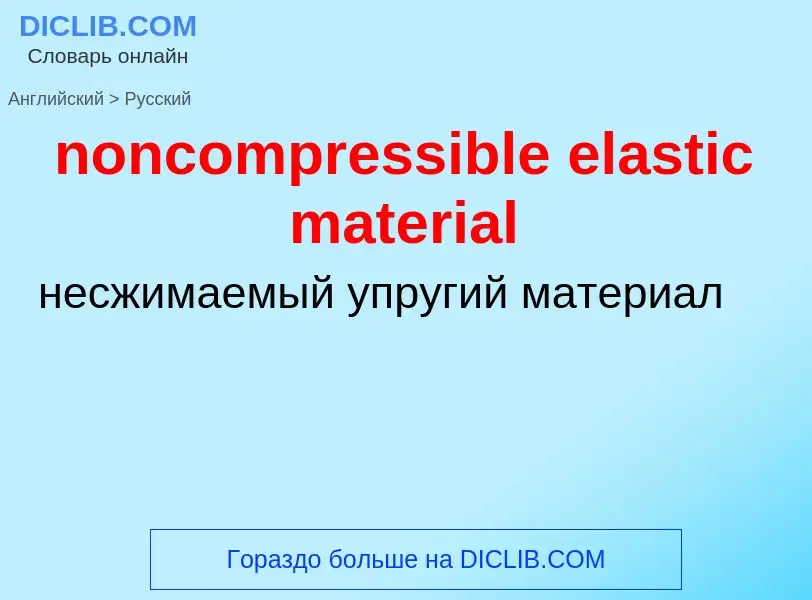Перевод и анализ слов искусственным интеллектом ChatGPT
На этой странице Вы можете получить подробный анализ слова или словосочетания, произведенный с помощью лучшей на сегодняшний день технологии искусственного интеллекта:
- как употребляется слово
- частота употребления
- используется оно чаще в устной или письменной речи
- варианты перевода слова
- примеры употребления (несколько фраз с переводом)
- этимология
noncompressible elastic material - перевод на русский
общая лексика
эластическая соединительная ткань
[i'læstik]
общая лексика
эластичный
упругий
эластик
прилагательное
общая лексика
эластичный
упругий
пружинящий
гибкий
растяжимый
быстро оправляющийся (от удара, горя)
гибкий и упругий
приспособляющийся
быстро оправляющийся (от огорчения, переживаний)
синоним
существительное
[i'læstik]
общая лексика
резинка
ластик
резинка (для вздёржки)
резиновая жилка
прорезиненный шнур
прорезиненная тесьма
резинка, подвязка
строительное дело
строительный камень (любая каменная порода, применяемая в строительстве)
общая лексика
стройматериалы
строительное дело
строительные материалы
общая лексика
исходный материал
сырье
Определение
Википедия
A hyperelastic or Green elastic material is a type of constitutive model for ideally elastic material for which the stress–strain relationship derives from a strain energy density function. The hyperelastic material is a special case of a Cauchy elastic material.
For many materials, linear elastic models do not accurately describe the observed material behaviour. The most common example of this kind of material is rubber, whose stress-strain relationship can be defined as non-linearly elastic, isotropic and incompressible. Hyperelasticity provides a means of modeling the stress–strain behavior of such materials. The behavior of unfilled, vulcanized elastomers often conforms closely to the hyperelastic ideal. Filled elastomers and biological tissues are also often modeled via the hyperelastic idealization.
Ronald Rivlin and Melvin Mooney developed the first hyperelastic models, the Neo-Hookean and Mooney–Rivlin solids. Many other hyperelastic models have since been developed. Other widely used hyperelastic material models include the Ogden model and the Arruda–Boyce model.






![Thick elastic fibers from the [[visceral pleura]] (outer lining) of the human [[lung]] Thick elastic fibers from the [[visceral pleura]] (outer lining) of the human [[lung]]](https://commons.wikimedia.org/wiki/Special:FilePath/STD 190219 SWITCH Tissue 2 93x CMLE 20SNR 50IT Elastin.png?width=200)

![Copper belfry of St. Laurentius church, [[Bad Neuenahr-Ahrweiler]] Copper belfry of St. Laurentius church, [[Bad Neuenahr-Ahrweiler]]](https://commons.wikimedia.org/wiki/Special:FilePath/20130816 Belfry of St Laurentius Ahrweiler.jpg?width=200)
![firestop mortar]] at CIBC bank in [[Toronto]]. firestop mortar]] at CIBC bank in [[Toronto]].](https://commons.wikimedia.org/wiki/Special:FilePath/Celotex thermax foamed plastic sheets.jpg?width=200)
![[[Falkirk Wheel]] [[Falkirk Wheel]]](https://commons.wikimedia.org/wiki/Special:FilePath/FalkirkWheelSide 2004 SeanMcClean.jpg?width=200)
![The [[Gliwice Radio Tower]] (the second tallest wooden structure in the world) in [[Poland]] (2012). The [[Gliwice Radio Tower]] (the second tallest wooden structure in the world) in [[Poland]] (2012).](https://commons.wikimedia.org/wiki/Special:FilePath/Gliwice-radiostacja.jpg?width=200)
![pipes]] penetrating a [[concrete]] floor in a Canadian highrise apartment building pipes]] penetrating a [[concrete]] floor in a Canadian highrise apartment building](https://commons.wikimedia.org/wiki/Special:FilePath/Piping floor penetrations nortown casitas.jpg?width=200)


![Mohaves]] in a brush hut Mohaves]] in a brush hut](https://commons.wikimedia.org/wiki/Special:FilePath/View of a group of Mohaves in a brush hut, one man very emaciated, entitled, by Wittick, Ben, 1845-1903.jpg?width=200)

